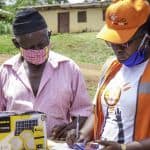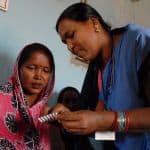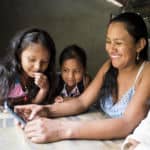Women Sales Agents are the Key to Last-Mile Distribution: Here are Four Ways to Maximize Their Impact
Women sales agents are establishing themselves as leaders in last-mile distribution. Many development and entrepreneurship programs around the world have tried to engage these sales agents as last-mile distributors, as their involvement can advance multiple business and impact goals. For instance, leveraging women sales agents can help businesses generate revenue, boost women’s economic empowerment, and bring needed goods and services to low-income communities poorly served by existing supply and logistics systems, thereby unlocking a new customer base.
But though some of these initiatives have succeeded, many have failed.
At Bopinc, we have worked with a number of private sector partners on marketing and distribution projects designed to create jobs for women entrepreneurs and reach low-income consumers. We recently concluded a project in Bangladesh — the Pushti Ambassadors Partnership — which aimed to increase women’s economic empowerment and improve nutrition in rural areas. The initiative, which was funded by the Danida Market Development Partnerships and conducted in partnership with Arla Foods, a major global dairy company, worked to grow the income of rural female microentrepreneurs by recruiting them to distribute Arla’s affordable dairy products. Under this project, we worked with 200 women entrepreneurs who were distributing on average 15 to 20 types of products, serving approximately 60,000 to 70,000 low-income consumers.
The Pushti Ambassadors Partnership was just one of many last-mile distribution projects we’ve worked on with women entrepreneurs, in countries ranging from Nigeria and Ethiopia to India and Bangladesh. Drawing on these experiences, we break down four key ingredients of a successful last-mile distribution model in this article, and show how we put them to use in the Pushti Ambassadors Partnership. We hope these insights will be useful to other businesses and programs that aim to enlist women sales agents in their own last-mile distribution efforts.
What is the ‘last-mile’ — and how can companies reach it?
We generally refer to the “last-mile” as the last leg of the journey that goods need to travel to reach consumers who live in places that are hard to reach. This could include rural places with poor road and transport links to other parts of the country, or urban communities that are not well-connected to the rest of the city. Often these last-mile communities are small and remote, making them difficult for traditional logistics systems and supply chains to reach.
How can companies efficiently deliver essential goods to these last-mile consumers? One option is to engage people already living in these communities to work as sales agents, who sell and distribute these goods in the communities where they live. These agents essentially become last-mile entrepreneurs. They might go door-to-door selling their wares, set up a kiosk in their home or a local market, or sometimes conduct “courtyard sessions” in a prospective customer’s house, to generate excitement about the products they are selling. As this work often requires them to access their customers’ households, women are the right candidates for the job, since women customers and their families may be uncomfortable allowing male sales agents into their homes in many conservative rural households.
Four key ingredients of successful last-mile distribution through women sales agents
There are several factors that make last-mile distribution models based on women agents successful. We’ve boiled these down to the following four key ingredients.
1: Remember the key to successful sales: location, location, location: As one would expect, the ideal location for last-mile distribution efforts is an area where competing products and services aren’t already widely available. However, there must be at least some purchasing power in the community, along with basic infrastructure in terms of roads — and investments must be made in market activation so local consumers are aware of the new products and their benefits. Along with these factors, we also need to consider the population density of a targeted market, as the agents will need to minimize their travel efforts and costs to reach consumers. This also determines the area an agent can cover and the total number of agents needed to fully cover the market.
2: Recruit agents with the right profile: The ideal sales agent is motivated, entrepreneurial, and already has some kind of family or community support, which can help her overcome the limitations of restrictive gender and social norms. Such norms pose a huge barrier to these models, though projects like ours can also help counter any norms and attitudes that may discourage women from working outside the home. It’s also important to recruit entrepreneurs who have some access to capital, since this can enable them to purchase the products they’ll be selling. However, distribution programs involving companies and development actors can also create microcredit facilities to support women entrepreneurs without existing capital in establishing their businesses. Alternatively, they can take an approach similar to that of the Pushti Ambassadors Partnership, which supported women entrepreneurs by providing them with product stock instead of capital, since handing over cash can create the risk of misutilisation.
3: Onboard new agents effectively: Once a distributor has found the right agents, it’s time to ensure that they are onboarded effectively and efficiently, so they’re able to sell the products and represent the brands they’re selling without excessive costs. Identifying the key capabilities needed by the agents, and then designing a lean onboarding model are key to ensuring commercial viability. Leveraging regular visits from sales supervisors to deliver onboarding training, or delivering training through digital materials can help drive down these costs. The first few weeks for an agent in operation is a delicate time — some agents might need more training than others. Investing in onboarding can both build their skills and help to identify high-performing and low-performing agents.
4: Perfect a route-to-market model: Once a distributor has established the right location, found the right entrepreneurs who are ready to be sales agents, and developed a lean onboarding process, the final ingredient is figuring out how to economically and reliably collect orders and deliver stock. Digital ordering platforms can reduce the costs of sales supervisors, but they are not a silver bullet solution. Connectivity, digital literacy and trust are key enablers that might require investment. Social norms also determine who female agents can interact with and under what conditions. Partnerships with, for example, existing cash-in-cash-out (CICO) networks can also be a win-win, lowering operational costs and expanding coverage areas; however, the geographies of both partners need to be well-aligned, so that these networks are located within a reasonable distance to agents. Once a viable route-to-market model has been established, it can also be used to expand into nearby locations that are contiguous to a distributor’s existing markets. This can be an effective strategic move to ensure the efficient scale-up of an agent network: By leveraging the infrastructure and market understanding already established in adjacent regions, a project can capitalize on synergies and shared resources to expand its reach. This approach can facilitate the smoother integration of new markets into an existing network, enhancing operational efficiency and optimizing overall business performance.
Combining these four ingredients into a sustainable last-mile distribution model
When these four ingredients are in place, we’ve found that they can substantially contribute to a sustainable last-mile distribution model. For example, in the Pushti Ambassadors Partnership program we implemented all of these ingredients. We identified locations that lied beyond Arla Foods’ regular distribution channels. We ensured that even though the company’s products were not heavily available in these areas, there was sufficient demand for them, and enough consumer purchasing power to afford them. While identifying the right location, we mapped the product distribution network so that once the agents were onboarded, we could ensure uninterrupted product supply. After ensuring appropriate locations and a reliable route-to-market, we recruited agents that met certain criteria that included entrepreneurial mindset, age group, family and community support, capacity to dedicate time and capital to their business, and sales and management skills. Once the agents were recruited, we conducted needs assessment exercises, and based on the results, we developed training plans and materials — along with tools for digital training. This training ranged from business management tools to sales techniques.
Based on our efforts to optimize this program, we’ve seen the kinds of impact a successful last-mile distribution model can enable. This impact starts with getting quality goods and services to people who really need them in hard-to-reach places. This benefits consumers who want to buy these goods and services, and it also benefits the companies that want to sell them, enabling them to develop a market share in places where they know there’s sufficient current demand — and the likelihood of even more demand in the future.
There can also be a positive impact for the women sales agents themselves. They have the opportunity to generate income, in places where there are generally very few other opportunities — especially for women. And through this work, they stand to gain not only income, but also more respect, independence and new skills. With these multiple pathways to both business and social impact, it’s easy to see why the use of women sales agents in last-mile distribution has gained so much traction in low-income markets in recent years.
Shihab Uzzaman is Project Manager – Marketing and Distribution, and Trisha Clauson is Program Director at Bopinc.
Photo courtesy of Bopinc.
- Categories
- Social Enterprise



